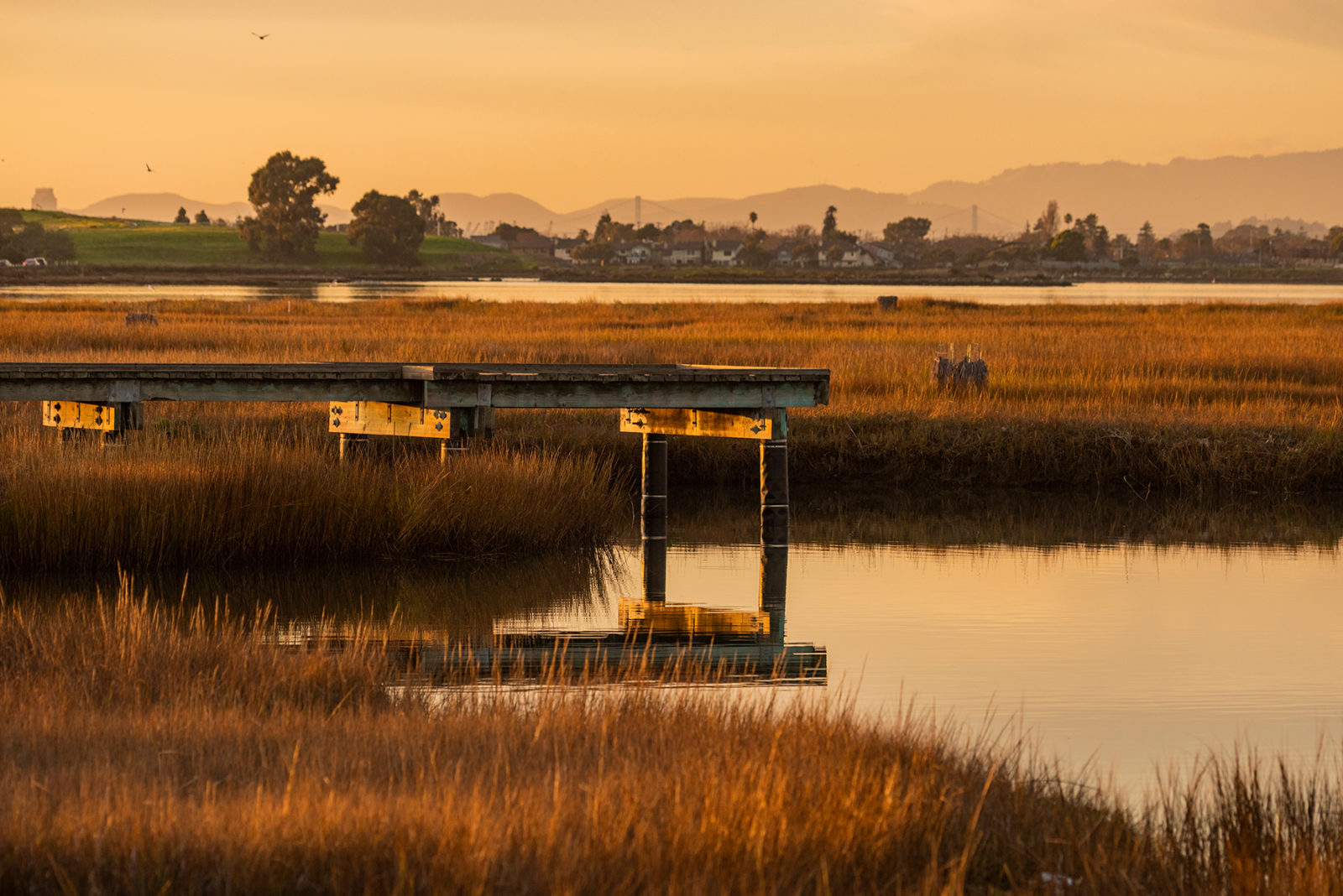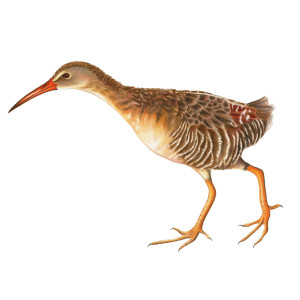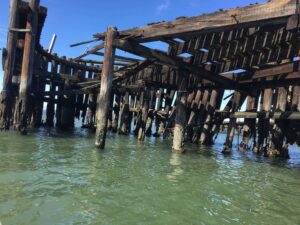I must have flown over this wetland dozens of times without knowing it existed. Now, a cloudy afternoon finds me standing on the path that runs along Arrowhead Marsh near the Oakland airport, waiting to meet East Bay Regional Park District naturalist Susan Ramos. We are here looking for endangered California Ridgway’s rails, secretive birds that are adapted to life in a salt marsh, spending most of their time foraging under or near the protective cover of dense, tall cordgrass. This park is one of the best places to see the elusive bird. Perhaps it’s their contradictions that makes seeking them out so exciting: Their noisy call tantalizingly announces their nearby presence, yet they can be impossible to spot. The challenge of identifying endangered species often leaves an amateur birder uncertain of what bird she or he saw, while Ridgway’s rails are rewardingly unmistakable. It’s also pure fun seeing this cocky orange-billed chicken-like bird among the flocks of small and comparatively drab sandpipers feeding on a mudflat.
To learn more about these federally endangered birds, check out the EBRPD’s wildlife volunteer opportunities, including a project that helps maintain and restore habitat for Ridgway’s rails. Visit ebparks.org and search for “wildlife volunteers.” EBRPD also offers bird walks at this marsh and nearby parks. Check the activity section at ebparks.org.
While Arrowhead Marsh is home to Ridgway’s rails, it’s immediately evident that the larger Martin Luther King Jr. Regional Shoreline, which contains several marshes, serves the human community as well. Joggers pass quickly, earbuds in their ears. A kid and his dad bike-ride by, their orange and purple helmets bright on a gray day. A mother pushes a toddler in a stroller, and someone is having a late lunch at the picnic table. Near me a fisherman pulls out a striped bass and then releases it, explaining he just catches and releases. When I set up my spotting scope, I am amazed at the variety of birds using this urban shoreline. With the Oracle Arena clearly visible to the east, and the Oakland International Airport just southwest, I am looking at hundreds of ducks, grebes, coots, and shorebirds.

Ramos arrives wearing shiny crab earrings that make me think of the rails’ diet of decapods, ribbed mussels, and amphipods; I wonder whether she’s chosen them today in tribute to the rail. As we walk, Ramos tells me that Arrowhead Marsh, which comprises 50 acres of wetland habitat that pokes into San Leandro Bay, likely resulted, in part, from an accidental dam breach. In the late 19th century, as Oakland grew rapidly, it needed a dependable water supply. Anthony Chabot, the hydraulic engineer who helped develop hydraulic mining during the Gold Rush, selected a site on San Leandro Creek for a 100-foot earthen dam that would create storage for 5 billion gallons of water. Hoses directed at hillsides, the same technique he had used in the Sierra, dislodged 600,000 cubic yards of dirt that were then moved by 800 Chinese “shovelmen.” Disaster struck when heavy rains in the winter of 1874 caused a dam breach that sent about 21,200 cubic yards of the compacted clay downstream. The arrowhead-shaped spit at the mouth of San Leandro Creek does not appear on an 1855 map, but it shows up on an 1895 map of the area.
Ramos and I are both used to talking birder-style: continually scanning for the elusive rails while we talk rather than look at each other. We know Ridgway’s rails are here, but they are shy birds. When frightened, they prefer running to flying, so even then they remain hidden in the cordgrass. They are most easily seen, and also most vulnerable, when high tides push them out of their protective cover. We check the edges of the channel where a snowy egret is fishing and the perimeter of a small island. We see willets napping in the pickleweed, a flock of dowitchers feeding with a marbled godwit that towers over them like Gulliver, and a few pairs of green-winged teal hugging the shallows as they dabble.

The taxonomy of the Ridgway’s rail was once almost as elusive as the bird itself. The rails in the San Francisco Bay were first thought to be a subspecies of the king rail, then later a subspecies of the East Coast clapper rail. It took DNA sequencing, and the persistence of ornithologist James Maley, to finally straighten out the taxonomy. Surprisingly, he found that the rails in San Francisco Bay were, in fact, most closely related to a third type of rail, those found in the Mexican highlands. This led to splitting the species and naming western birds Ridgway’s rails in 2014. Ridgway’s rail was further split into six subspecies, with our San Francisco Bay bird becoming the California Ridgway’s rail (Rallus obsoletus obsoletus).
While some people consider “lumping” and “splitting” academic, a unique classification may have helped the Ridgway’s rails survive. If they had been classified as identical to East Coast clapper rails, the California populations would not have been protected in 1970. But as a unique subspecies—first called the California clapper rail—they gained protection under the Endangered Species Act.
Suddenly a loud “kek-kek-kek” bursts from the cordgrass to our left. Ramos and I turn and grin at each other. Even getting to hear that telltale Ridgway’s rail call is special. It’s hard to believe that these rails were once plentiful around San Francisco Bay. An 1897 newspaper account refers to a week in which 5,000 clapper rails were legally killed—that’s greater than the total number of California Ridgway’s rails alive today. Such for-market hunting was curtailed by the Weeks-McLean Law of 1913.
Although Ridgway’s rails are not dodging literal bullets now, they still face challenges. San Francisco Bay may have lost more than 90 percent of its original wetlands; San Leandro Bay, once 1,800 acres of tidal marsh, was reduced to just 76 acres by 1986. The remaining habitat is compromised by sea level rise and the introduction of four species of non-native cordgrass that have the potential to irreparably alter the Bay’s wetland habitats. The particularly problematic Atlantic cordgrass (Spartina alterniflora) hybridizes with the native Pacific cordgrass (Spartina foliosa), and those hybrids can be pollinated by Atlantic, Pacific, and hybrid cordgrasses, creating a “hybrid swarm” that can out-compete the native cordgrass. Between 1995 and 2008 this invasive hybrid spartina expanded to more than 50 percent of the wetland area at Arrowhead Marsh.
Ironically, the number of Ridgway’s rails increased at Arrowhead with the invasion of the hybrid cordgrass; the rails seemed to find the denser cover attractive. But it falls to scientists to take the long view. As Marilyn Latta, project manager at the State Coastal Conservancy, explains, a monoculture of this hybrid cordgrass would ultimately be detrimental, not just to rails but to other birds as well. The roots of Spartina alterniflora x foliosa change the soil chemistry, which impacts the benthic invertebrates that are essential food for many migratory and resident birds. Also, Ridgway’s rails and other probers can struggle to get their bills down in the mud through the dense network of roots to reach some of their sources of food.

The California Coastal Conservancy and the U.S. Fish and Wildlife Service’s San Francisco Bay National Wildlife Refuge Complex formed the San Francisco Estuary Invasive Spartina Project (ISP) in 2000 to coordinate a response. Today the ISP has more than 150 partners from all Bay Area counties, and each hybrid spartina site has been evaluated for an herbicide’s effect on adjacent areas and the estuary as a whole.
All the careful planning and hard work have been a success, reducing the hybrid cordgrass growth from more than 800 acres in 2005 down to 37 acres in 2018 in the Bay. But as the cordgrass cover declined, so did Ridgway’s rails in some areas. As the native wetland habitat is restored, the option of moving Ridgway’s rails to these new areas is under discussion.
When it was time to rid Arrowhead Marsh of hybrid spartina in 2005, this was such a rail hot spot that USFWS decided to stagger the treatment so as not to have all their rail eggs in one basket. The west section was initially sprayed aerially with Imazapyr, an herbicide classified by the EPA as minimally toxic to mammals, birds, fish, and aquatic invertebrates. The solution was later switched to a diluted form of Imazapyr that was applied to the spartina to prevent it from flowering and setting seed. The treated area’s growth became mostly the low-growing succulent pickleweed, and the eastern section has not been treated.
Doug Bell, wildlife program manager at East Bay Regional Park District, raised another concern. Arrowhead Marsh is a low-elevation marsh, so at king tides the marsh sits almost entirely underwater, and the rails have practically no cover in which to hide from predators. As a result, the district is considering raising the marsh plain in a phased process. Bell is also taking into account the prospect of sea level rise subsuming the marsh, in which case the work involved in raising the marsh plain might be preferable. Scientists at Point Blue Conservation Science have created the Future Marshes San Francisco Bay website, outlining different climate change scenarios over the next 90 years. In the worst-case scenario—with sea level rise at the high projection and sedimentation at the low projection—Arrowhead Marsh would no longer support a population of Ridgway’s rails. Knowing the clock is ticking, scientists from a variety of disciplines are coming up with possible solutions, such as what Bell calls “postage stamp” habitat, a small elevated area in the southwest corner of Arrowhead Marsh. Or if temporary translocation of rails is successful in USGS projects, officials wonder, might a permanent move be possible if Arrowhead Marsh were to disappear with sea level rise?
It is getting late, and the Ridgway’s rail has not shown up. I see a familiar look on Ramos’ face. I have seen that expression on the faces of marine biologists when whales didn’t show up for a whale-watching tour. “Well, at least we heard them,” we console each other. As we head back to the parking lot, I suddenly spot a Ridgway’s rail below an undercut bank, so close I don’t even need the spotting scope! As if to give us a better view, it struts out onto the mudflat and preens each wing in turn with its thick, orange bill. It strikes me as wonderfully ironic that after decades of birding, this urban setting is the closest view I have ever had of the endangered bird! The rail gives a quick jab at the mud without catching anything, then turns and disappears. “Yay!” Ramos is jubilant. “Persistence pays off.” And I offer silent thanks to all the scientists and volunteers who persistently work so hard to save the Bay so that all of us can enjoy these special moments.





